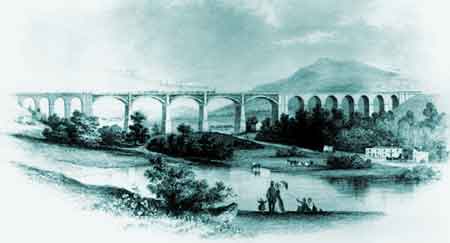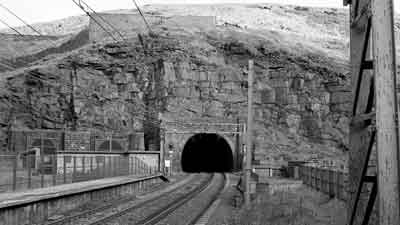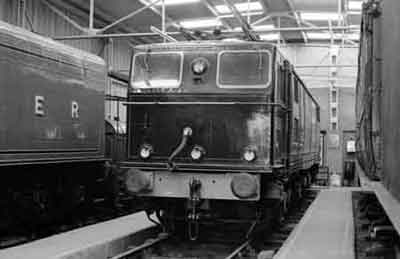
The Sheffield, Ashton-under-Lyne and Manchester Railway Company was incorporated on the 5 May 1837 and its purpose was to build and operate a railway line between Sheffield and Manchester, its route being via Penistone and Woodhead. The choice of route necessitated the construction of a single-track tunnel at Woodhead, which opened on the 22 Dec 1845.
At this time, the centrepiece of the railway was Dinting Viaduct across Dinting Vale, Glossop, known as 'Dinting Arches'. This was initially built with seven stone arches at the southern end, four stone arches at the northern end and in the centre, spanning Glossop Brook and the A57 road, five lattice arches of Baltic timber, each spanning 125 feet, supported by stone piers. In the 1850s the Baltic timber arches were replaced by wrought-iron girders and in 1918/19 seven blue brick strengthening piers were built in the centre.

The original Dinting Viaduct.
On the 27 Jul 1846 the Manchester, Sheffield and Lincolnshire Railway Company was incorporated and on the 1 Jan 1847 the Sheffield, Ashton-under-Lyne and Manchester Railway Company amalgamated with other companies to form the Manchester, Sheffield and Lincolnshire Railway Company. The other companies involved were:
The Sheffield and Lincolnshire Junction Railway Company
The Great Grimsby and Sheffield Railways Company
The Grimsby Docks Company
The railway between Sheffield and Manchester was an immediate success and the volume of trade carried was such that it required the construction of a second single-track tunnel at Woodhead, which opened on the 2 Feb 1852.
In 1888 Lord Wharncliffe opened a new station at Wortley. He was the third Lord Wharncliffe and he became Chairman of the Manchester, Sheffield and Lincolnshire Railway Company in 1874. He played a major role in the formation of the Great Central Railway Company in 1897.
Although the company's main sphere of operation lay across the Pennine Hills between Yorkshire and Lancashire, it had opened an extension to London by 1897. To reflect the importance of the London extension, the company changed its name to the Great Central Railway Company on the 1 Aug 1897.
After the end of the Great War (1914/18), it was thought necessary to restructure Britain's railway system and an Act of Parliament was passed in 1921 that permitted the formation of the Amalgamation Tribunal. One outcome of the deliberations of this tribunal was the North Eastern, Eastern and East Scottish Scheme and on the 12 Dec 1922 it was announced that the Great Central Railway Company was to cease to exist at the end of 1922 to become an integral part of the London and North Eastern Railway Company (LNER) on the 1 Jan 1923.
During the first half of the 1930s, consideration was being given to a plan to electrify the railway over Woodhead between Sheffield and Manchester and in 1936 work started. The reason for the electrification of the line was primarily to carry the heavy west bound coal trains from the South Yorkshire coalfield to Manchester. It would also enable passenger trains to be electrically hauled between Sheffield and Manchester as well as suburban services from Manchester to Hadfield and Glossop.
Work on the line itself had to be postponed due to the intervention of the Second World War on the 3 Sep 1939 but work continued on the design and production of the prototype electric locomotive. In 1940, the frame of this locomotive was laid and in 1941 the first Bo-Bo locomotive (LNER No. 6701, renumbered 6000 in 1946) was completed. In 1947 it was loaned to the Netherlands and on its return in 1952, it was named 'Tommy' to commemorate the British soldiers who helped to liberate Europe during the Second World War. This was done at a special ceremony held at Liverpool Street Station on the 30 Jun 1952, the naming being done by Netherlands State Railway President, F G den Hollander. It was renumbered as 26 000 in 1953 and was withdrawn from service in Apr 1970, as E26 000, to be cut up at Crewe in Oct 1972.
On the 1 Jan 1948 the London and North Eastern Railway Company was nationalised under the terms of the 1947 British Transport Act, which created the British Transport Commission and British Railways. This did not spell the end of the proposed electrification scheme and work commenced on boring a third Woodhead Tunnel. This was double tracked and when it was completed in 1953 it became the centrepiece of the modernisation scheme. The third tunnel opened for regular working on the 14 Jun 1954. The final stage of construction work on the new line was on the 3 Jan 1955. When the line was completed, it became Britain's only main line to be electrified at 1,500V dc overhead. Its opening created Britain's first all-electric main line railway.

The western portals of the three Woodhead tunnels.
From left to right: Woodhead 2 (north tunnel , 1852), Woodhead 1 (south tunnel, 1845) & Woodhead 3 (double tracks, 1953).
The wires extended from Wath Marshalling Yard, near Mexborough, Tinsley Marshalling Yard, Sheffield and Victoria Station, Sheffield, to London Road Station (later Piccadilly Station), Manchester. Wath Marshalling Yard was set at the centre of the South Yorkshire Coalfield at Wath upon Dearne, close to Wath Main and Manvers Main Collieries, and it was one of Britain's first modern hump marshalling yards forming the hub of a large coal distribution network. In the 1960s, with the building of the large Tinsley Marshalling Yard, the wires were extended from Woodburn Junction near Darnall Shed to this new marshalling yard. Stations on the line between Sheffield Victoria and Manchester Picadilly were as follows:
The renowned Metropolitan Vickers Electrical Company of Trafford Park, Stretford, Manchester, and of Sheffield, supplied all the electrical equipment for both classes of electric locomotives, that is, the Bo-Bo EM1s (later Class 76) and the Co-Co EM2s (later Class 77). The locomotives themselves were built at the railway company's Gorton Works, Manchester, better known as 'Gorton Tank'.
A Bo-Bo locomotive has two bogies, each having two axles and therefore two pairs of wheels. A Co-Co locomotive has two bogies, each having three axles and therefore three pairs of wheels.
The EM1s were primarily intended for freight duties with a 65 miles per hour maximum speed and 14 of these were built with boilers to make them suitable for passenger service. The EM2s were express passenger locomotives with a 90 miles per hour maximum speed and all were fitted with boilers.
Details of Class EM1 & EM2 locomotives » Locomotives
In Mar 1968, all of the Class 77 locomotives were withdrawn from service to begin a new life in the Netherlands. Nonetheless, scheduled passenger services between Sheffield and Manchester continued but the Class 76 locomotives now hauled them. These scheduled services continued until 1970 when the through line was closed for passengers.
On the 17 Jul 1981, the last freight train ran the full length of the line and on the 20 Jul 1981 the line between Penistone and Hadfield, including Woodhead Tunnel, was officially closed. Afterwards, all but one of the Class 76 locomotives was scrapped. The sole survivor was 76 020 (formerly 26 020). This was built at the Gorton Works, Manchester, in 1951. It was on display at the Festival of Britain Exhibition, South Bank, London, in 1951 and it was used to haul the special train that opened the third Woodhead Tunnel in 1954. It was withdrawn from service in 1977 to be refurbished at Doncaster to its original style and number. It was placed in the National Railway Museum at York in 1978.

Preserved British Rail Class EM1 Bo-Bo No. 26 020, Jul 1981.
The locomotive is seen here in its original style and black livery at the former Dinting Railway Centre, Glossop.
The Centre was run by the Bahamas Locomotive Society and it was open from 1968 until 1990.
The 1,500V dc Class 506 Electric Multiple Units (EMUs) used on the Manchester-Glossop-Hadfield section of Woodhead Railway were withdrawn in 1984 and subsequently this section was converted to 25,000 V ac operation using Class 303 Electric Multiple Units.
Details of Class 506 EMUs » Units
The line between Penistone and Deepcar was closed in 1983 and Huddersfield trains were diverted through Barnsley. A single-track line had been left between Deepcar and Hadfield and in 1986 this was lifted and subsequently the trackbed was blocked by road construction. The remaining sidings at Deepcar were lifted in 1994 and the former main line there was connected to the railway system of a steelworks. Bridges at Bullhouse and Hazelhurst were removed in 1997 to be replaced by footbridges.
The Museum of Science and Industry, Manchester, has the No. 1 cab of EM1 locomotive 76 048 'Hector', as well as the complete EM2 locomotive 27 001 'Ariadne'. The latter was returned to this country after it was withdrawn from service in 1986 on condition that it retained its Netherlands State Railway livery. The only other complete EM2 locomotive to have survived in the UK is 27 000 'Electra', which has been refurbished in its original style and is now preserved in the Midland Railway Centre, Butterley, Derbyshire.
Click thumbnails for full pictures, then click browser back button/arrow to return here